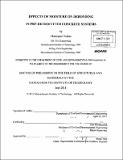| dc.contributor.advisor | Oral Büyüköztürk. | en_US |
| dc.contributor.author | Tuakta, Chakrapan, 1980- | en_US |
| dc.contributor.other | Massachusetts Institute of Technology. Dept. of Civil and Environmental Engineering. | en_US |
| dc.date.accessioned | 2011-11-01T19:53:22Z | |
| dc.date.available | 2011-11-01T19:53:22Z | |
| dc.date.copyright | 2011 | en_US |
| dc.date.issued | 2011 | en_US |
| dc.identifier.uri | http://hdl.handle.net/1721.1/66855 | |
| dc.description | Thesis (Ph. D.)--Massachusetts Institute of Technology, Dept. of Civil and Environmental Engineering, 2011. | en_US |
| dc.description | Cataloged from PDF version of thesis. | en_US |
| dc.description | Includes bibliographical references (p. 169-176). | en_US |
| dc.description.abstract | FRP (fiber reinforced polymer) retrofit systems for reinforced concrete (RC) structures have been widely used in the past 10 years, and numerous studies on its short-term debonding behavior have been conducted extensively. Nevertheless, long-term performance and durability issues regarding such debonding behavior still remain largely uncertain and unanswered. In this study, comprehensive experimental and analytical investigations of debonding in FRP bonded concrete systems under long-term environmental exposure, namely moisture, have been performed to develop mechanics-based predictive debonding failure models and related design tools for the prevention of debonding failures. The experimental approach involves an investigation of debonding under moisture ingress, moisture reversal, cyclic moisture conditioning, using the concept of fracture mechanics and meso-scale tri-layer fracture specimens. Prolonged exposure to moisture condition has been shown to result in significant degradation of the FRP/concrete bond strength, while an irreversible weakening in the bond strength has also been observed in the fracture specimens under moisture cyclic condition. A predictive model has been developed based on the experimental results of the fracture specimens under variable cyclic moisture conditions for service life prediction of the FRP-strengthened systems. To incorporate this quantification method and experimental data, finite element analysis and correlation study have been conducted for RC beams externally strengthened with FRP plate. The cohesive zone model for interfacial fracture has been implemented, for which the properties of the interface were obtained from the meso-scale fracture tests. Test on laboratory-scale FRP-strengthened RC beam specimens under continuous moisture conditions has demonstrated the applicability of the methodology. In addition, molecular dynamics simulation has been conducted to gain more fundamental understanding of interface fracture behavior in bi-layer material systems (i.e. crack initiation and propagation direction) and the effects of material and interface properties at atomistic scale. Finally, a recommendation has been made to the current design of RC beams strengthened with FRP to prevent premature failure due to long-term exposure to moisture. | en_US |
| dc.description.statementofresponsibility | by Chakrapan Tuakta. | en_US |
| dc.format.extent | 195 p. | en_US |
| dc.language.iso | eng | en_US |
| dc.publisher | Massachusetts Institute of Technology | en_US |
| dc.rights | M.I.T. theses are protected by
copyright. They may be viewed from this source for any purpose, but
reproduction or distribution in any format is prohibited without written
permission. See provided URL for inquiries about permission. | en_US |
| dc.rights.uri | http://dspace.mit.edu/handle/1721.1/7582 | en_US |
| dc.subject | Civil and Environmental Engineering. | en_US |
| dc.title | Effects of moisture on debonding in FRP-retrofitted concrete systems | en_US |
| dc.type | Thesis | en_US |
| dc.description.degree | Ph.D. | en_US |
| dc.contributor.department | Massachusetts Institute of Technology. Department of Civil and Environmental Engineering | |
| dc.identifier.oclc | 758001007 | en_US |
